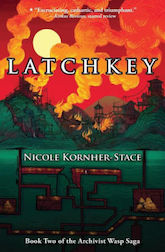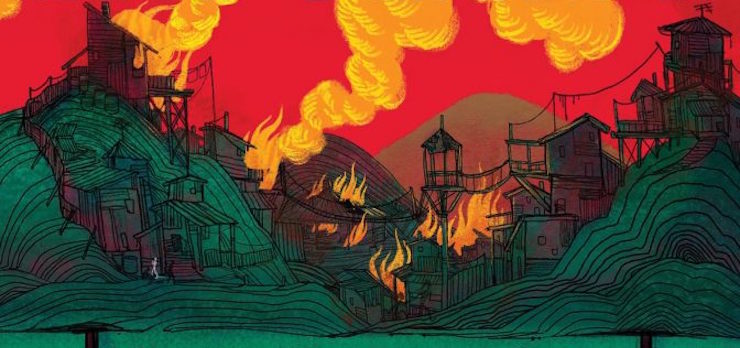What do you call a ghost story that doesn’t feel remotely like a ghost story? Nicole Kornher-Stace’s novel Archivist Wasp brought together a host of seemingly disparate elements that would normally clash and turned them into a bizarre and compelling coming of age story abounding with surreal adventures in a postapocalyptic landscape. At the heart of it was a young woman then known as Wasp, who embarked on a journey to strange landscapes both tactile and metaphysical, assisted by the nameless ghost of a soldier.
Kornher-Stace’s take on ghosts departs from conventional portrayals of revenants and spectres. Some are largely dissipated, almost cartoonish shells of the people they once were. Others are as tactile as the humans with whom they interact: the ghost featured prominently in Archivist Wasp is a prominent example. The highly advanced ghosts also wear clothing, possess weapons, and can interact with the physical world in the same manner as the living. It feels somewhat reminiscent of the angels in the film Wings of Desire; additionally, the notion of ghosts possessing an energy akin to fuel recalls both Tim Powers’s Expiration Date and, more recently, Hannu Rajaniemi’s Summerland. But the uneasy coexistence of a ravaged future landscape and the presence of the restless and tactile dead sets this fictional setting apart, and makes it particularly memorable.
Buy the Book


Latchkey
Latchkey is Kornher-Stace’s followup to Archivist Wasp. Three years have passed since the earlier novel; Wasp is now known as Isabel, and the community in which she resides has become a more equitable one. But this is hardly an idyllic stroll through a less-devastated future than its predecessor. Instead, a host of events take place that clarify just how tremulous Isabel’s way of life is. A violent group attacks their village, and in attempting to save lives, Isabel discovers a structure that hearkens back to the time when the ghost she’d met in Archivist Wasp was still among the living.
Said ghost is not the only character from Archivist Wasp to return here; like that novel, this one also features explorations of “the ghost-place” and explores some of the peculiar properties of this novel’s handling of the afterlife. It also contains a much greater sense of who the ghost was in his past life, and what the futuristic society that trained him in the art of soldiering had in mind.
The ghosts of some of his compatriots, including the lethal Catherine Foster, also make appearances here—some equally functional, others stuck in loops or mindlessly flailing, causing damage in their wake. The title refers to the program under which they were trained, and a series of flashbacks, conveyed viscerally, fleshes out their world, and offers glimpses of some very human horrors. In this way, then, Latchkey feels like a very archetypal sequel: increase the danger level for the protagonist, deepen the backstories of the supporting cast, and introduce some mysteries that may spur further conflict in future books. Which, assumably, are in the cards: the cover bills this as “Book Two of the Archivist Wasp Saga.”
In the book’s acknowledgements, Kornher-Stace alludes to a somewhat turbulent publishing history for this book, including “amicably parting ways” with Small Beer Press, who’d released Archivist Wasp. She also notes that, while she thought that she might return to this world, she “didn’t pitch [Archivist Wasp] as a series or trilogy or what-have-you.” What that in mind, though, this still feels very much like a middle book in a trilogy: there’s the expansion of the world, some echoes of its predecessor’s plotline, and the aforementioned setup for more: while the book resolves most of its conflicts by the time it reaches its final page, it also lays the groundwork for a subsequent volume.
That isn’t necessarily a criticism: I should state outright that it does so quite well. The combination of two future timelines—one of a ruined earth, and one of the militaristic one that preceded it—continues to tantalize in terms of how one led into the other, and whether some of the strange properties of Isabel’s world have their roots in the earlier period. And the multiple conflicts on display—humans against humans, humans against ghosts, ghosts against ghosts—offer a fascinating and constantly shifting backdrop for Isabel’s discovery of the secret history of her world. In both this book and its predecessor, Kornher-Stace has created and developed a singular fictional setting—but Latchkey is at its best when it embraces that originality, rather than returning to more familiar narrative beats.
 Tobias Carroll is the managing editor of Vol.1 Brooklyn. He is the author of the short story collection Transitory (Civil Coping Mechanisms) and the novel Reel (Rare Bird Books).
Tobias Carroll is the managing editor of Vol.1 Brooklyn. He is the author of the short story collection Transitory (Civil Coping Mechanisms) and the novel Reel (Rare Bird Books).










